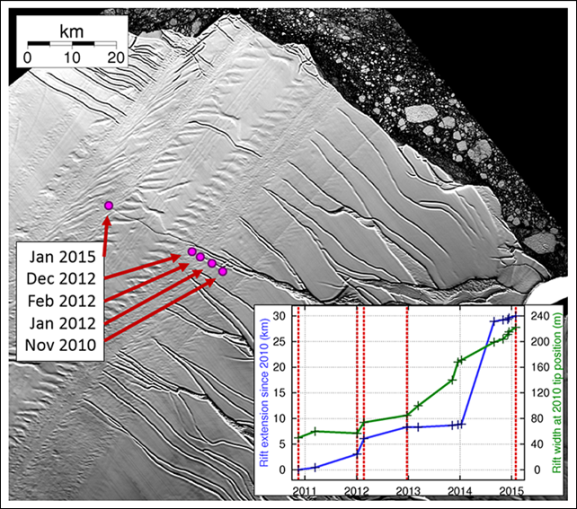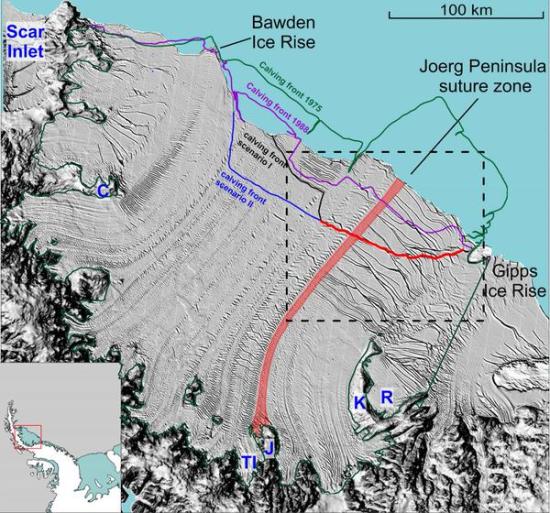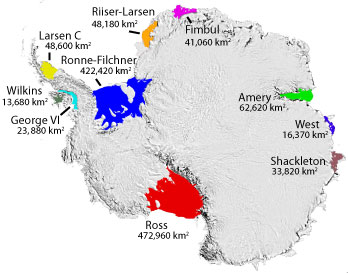Another
Blow to Antarctic Glacial Stability as Larsen C Ice Shelf Cracks Up
24
February, 2015
(Northern edge of Larsen C Ice Shelf is at significant risk of breaking off as a massive rift continues to open within it. The above image shows the rate of rift propagation since November of 2010. Image source: Cryosphere Discussions.)
There’s
a 30 kilometer long and hundreds foot deep crack running through West
Antarctica’s massive Larsen C ice shelf.
It’s
a rift that now stretches from the Weddell Sea — where winds and
currents have driven human-warmed ocean waters to up-well along the
ocean-contacting faces of the great Antarctic ice sheets — and deep
into the interior of this 49,000 square kilometer and 600 to 700 foot
tall block of ancient, floating ice.
Over
the past few years this rift has been rapidly advancing at a rate of
about 2.5 kilometers each year. Given that the rift has already
traversed more than half of the Larsen C ice shelf calving face, a
very large break-up could now occur at almost any time.
Larsen
C Destabilizing
This
evolving situation now threatens to destabilize the entire Larsen C
ice shelf — resulting in major losses to a very large block of ice
that has been a permanent feature of the Antarctic coastline since at
least the last interglacial period 150,000 years ago. Such rapidly
evolving risk was the subject of a February 5 communication by a
group of glaciologists warning that “significant threats” to
“Larsen C ice sheet stability” now existed.
The
report notes:
In
a change from the usual pattern, a northwards-propagating rift from
Gipps Ice Rise has recently penetrated through the suture zone and is
now more than halfway towards calving off a large section of the ice
shelf (Figs. 1 and 2). The rate of propagation of this rift
accelerated during 2014. When the next major calving event occurs,
the Larsen C Ice Shelf is likely to lose around 10 % of its area to
reach a new minimum both in terms of direct observations, and
possibly since the last interglacial period (Hodgson et al.2006)
Connecticut-Sized
Break-up Possible
Large
ice shelf break-ups have been occurring along the Antarctic Peninsula
since the 1970s. As human warming advanced and the heat sink of the
southern Ocean increased bottom water temperatures along the
Antarctic perimeter, many of the far northern ice shelves and an
increasing number of ice bodies closer to the Antarctic interior have
lost significant portions of their mass.
Now,
Larsen C is at risk of an even worse break-up. For the predicted 10%
loss to Larsen C would equate to about 5,000 square kilometers — or
an area roughly the size of Connecticut — floating off into the
Southern Ocean:
(Larsen C Ice Shelf map with the new rift indicated in red and the potential calving face outlined in blue. Note the previous calving fronts in 1975 and 1988. Image source:Cryosphere Discussions)
It
would be yet one more major ice loss for the region, and perhaps a
new record loss for an area that has frequently seen Rhode Island
sized chunks of ice (around 1,000 square kilometers) break off into
the warming world’s seas.
The
report goes into further detail about the importance and
vulnerability of Larsen C, stating:
The
Larsen C Ice Shelf is the most northerly of the remaining major
Antarctic Peninsula ice shelves and is vulnerable to changes both to
ocean and atmospheric forcing (Holland et al., 2015). It
is the largest ice shelf in the region and its loss would lead to a
significant drawdown of ice from the Antarctic Peninsula Ice Sheet
(APIS). There have been
observations of widespread thinning (Shepherd et al., 2003; Pritchard
et al., 2012; Holland et al., 2015), melt ponding in the northern
inlets (Holland et al., 2011; Luckman et al., 2014), and a speed-up
in ice flow (Khazendar et al., 2011), all processes which have been
linked to former ice shelf collapses (e.g. van den Broeke,
2005).(Emphasis Added).
Conditions
in Context
As
mentioned above, during recent years we have seen numerous ice
shelves and ice sheets begin to destabilize. In addition, two ice
shelves — Larsen A and Larsen B have already completely
disintegrated due to human-caused warming.
Larsen
C may be most immediately at risk, but the leading edges of the
Ronne-Filchner Ice Shelf, The Pine Island Glacier, The Ross Ice
Shelf, and the Amery glacier have all shown rapid seaward
acceleration. Further, various studies of these increasingly
vulnerable ice shelves have shown substantial basal melt coincident
with a floating of the ice sheets off grounding lines, leading to a
retreat of the anchor points landward.
(Antarctica’s major ice shelves. Image source: Commons.)
Sea-facing
ice sheets and ice shelves serve to anchor the great interior
glaciers of Antarctica. Loss or destabilization of these anchors
would result in more and more rapid flow of land ice into the
Southern Ocean. It is for this reason that the destabilization and
shattering of ice shelves like Larsen C can have serious implications
for the rate of sea level rise over the coming decades.
Overall,
nearly 200 feet worth of sea level rise is locked in Antarctica’s
glaciers and we are, through a heating of the world’s oceans, ice,
and atmosphere, pushing these glaciers to melt and move in an
ever-more dramatic and world-altering fashion.
Links:
Hat-tip
to Colorado Bob






No comments:
Post a Comment
Note: only a member of this blog may post a comment.